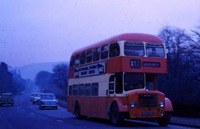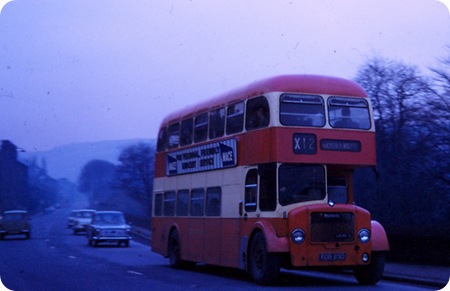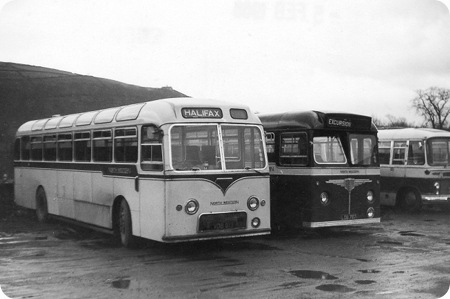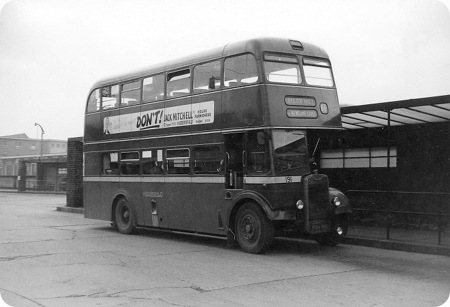North Western – Dennis Loline III – RDB 890 – 890
North Western Road Car
1961
Dennis Loline III
Alexander H39/32F
Not the best photographic shot in the world, taken on a very cold, misty winters day, but I think well worth showing. North Western mainly used single deckers on the X12 Manchester to Bradford route but on this day look what turned up. The radiator of the Dennis could have been improved with a bit of chrome or something, just looks a bit austere to me when compared to the Lodekka which this bus is a copy of, for a good example of how Bristol did it click here.
———
They tended to use double decks on the X12 on busy Saturday mornings, I often used to travel on the X12 at about 12:30 from Slitheroe Bridge, quite often there would be a Renown, sometimes duplicates and standing room only, YWD would supply Lowlanders on Saturdays. This would be mid 1960’s
Christopher
I have an anecdote which might explain the gloomy nature of the above image. In the early sixties I spent a Saturday evening in Manchester at the Granada TV studios. It started raining before we left Bradford, on the moors the rain was horizontal and driven by the ferocious winds for which those parts were/are famous. On our return police informed us that we had to detour VIA SHEFIELD as there was a wash-out on the Halifax road.
The next day I was in Chester Street (Bradford) bus station when a North Western Loline III arrived from Manchester. I took the Loline on its return journey out of curiosity to know how the wash-out had been bridged.
Overnight a Bailey bridge had been laid across the gap to ensure that the road was closed for less than 24 hours. Bear in mind that there was no M62 in those days.
This was a unique journey for me as the weather was very much as depicted in the image What was more significant for me was that this was the only time I recall doing the journey on a double decker.
Charles
With regards to the use of double deckers on service X12 [Manchester- Bradford]. The service was run during the week by Yorkshire Woollen using single deckers. At the weekend two Daimler Fleetlines would be borrowed from West Riding at Belle Isle depot Wakefield as there was a heavy passenger demand mainly immigrants seeing their families in Oldham.
Philip Carlton
Phillip,
To what era are you referring above?
I ask because I do not recall the prodigious use of ‘deckers on the X12 in the early sixties. Perhaps your memories are from NBC days because you mention West Riding and YWD.
My main interest lay in the exotica from the other side of the Pennines that was placed on this service.
North Western indulged my love of AECs by providing one of its famous DP Reliances. These were exotic to my mind because of the dark red and black livery on their Alexander bodies. The livery certainly stood out on the stand in Chester Street bus station along side those with which I was more familiar.
I understand that one was repatriated for preservation some time ago. Does anyone have news of its whereabouts and current preservation status.
Charles
I remember one Saturday in the 1960s when a sizeable fleet of duplicates came over the Pennines on the X12, bringing footie fans to Manchester. I have no idea what the match was, but the buses were (I kid you not) Yorkshire Woollen PS1 double deck rebuilds!
Peter Williamson
That explains a lot this was probably a one off footy special It certainly was not a regular event as most licenses for football excursions were held by Wallace Arnold.
I can state categorically that North Western operated on he X12. It was a route shared with at least one other company (YWD?) maybe two. I doubt that West Riding operated on the service during the early sixties because it was still a private company.
The sighting of a WR bus suggests to me that this took place during the birth pangs of The National Bus company when things that might have been considered worthy of comment a few years before became commonplace.
Charles
I am left a little baffled by Charles’s reference to black and red painted Alexander bodywork. North Western’s famous "black top" dual purpose livery was first applied to a batch of Weymann bodied Reliances in 1957 and then to further Reliances and Tiger Cubs with Willowbrook bodywork in 1958-61. No Alexander bodied vehicle ever wore this livery. The repatriated survivor referred to is Willowbrook bodied Tiger Cub LDB 796 which spent some time in Belgium before being brought back to the UK by Stephen Morris of Rexquote/Quantock fame. He later sold it to two gentlemen in the North of England who are members of the Ribble Vehicle Preservation Group and the bus is often to be found at rallies parked next to their Ribble machines.
I last saw it yesterday at the British Commercial Vehicle Museum’s Leyland Homecoming event and it always warms my heart. Back in its service days it ran from Wilmslow depot for a while and was often to be found on the 97 route from Altrincham to Macclesfield. At that time the A538 road crossed the main runway at Manchester Airport with a "level crossing" type barrier in use to prevent conflict between landing airliners and road traffic! What I’d give for a photograph of this.
Sorry, I’m waxing nostalgic at far too great of a length….
Neville Mercer
North Western’s famous black-top Reliances were bodied by Weymann and Willowbrook, not Alexander. They had high-backed bus seats but were treated as dual-purpose by North Western. The Alexander ones had coach seats and were painted in coach livery. One of the Willowbrook ones was my first ever experience of an AEC Reliance, and remains such a fond memory that it is the subject of the one and only model in my "collection" – RDB 871. I do believe a real one still exists, but not in a good state. However, a Tiger Cub with identical black-top Willowbrook body – LDB 796 – is currently active on the rally circuit, re-engined with an O400.
Peter Williamson
I am sorry to have confused you, Neville. I was Not really familiar with companies from the red rose county. I will insert the usual disclaimer about the passage of time clouding the memory banks but it is over forty years since I last used the X12.
As an all time AEC man the one thing that has not been obscured is the fact that the X12 was the longest route on which I could regularly ride on a reliance. I was used to using Bristol/ECW buses on my home turf and I welcomed a ride on a black top because they had opulent interiors compared with their Bristol counterparts. I always thought that a ride on a blacktop was the perfect start to a day’s bus spotting in Manchester. The scenery en route was spectacular.
Charles
I have just Googled X12 Manchester-Bradford and have come up with a very interesting photopic presentation.
As well as images it contains a potted history of the route which confirms that the other operator WAS indeed, YWD. It also confirms that West Riding vehicles could have been used as the NBC placed the two companies under common management.
I had emigrated in 1969 so I missed out on all the hoo-ha surrounding NBC’s early days in the region. It came as a complete surprise to learn that Ribble took over operation of the route when North Western was subsumed into SELNEC PTE.
I hope this will prompt more reminiscences of this fascinating route.
Charles
I have just been reading a short article on West Riding which appeared in the June 2007 edition of Bus And Coach Preservation p49-50.
You who were closer to to the scene at the time will realise that I have been again mistaken. It was YWD and the coaching arm of Hebble that NBC placed under Wet Riding management in 1970. A year later the three fleets were renumbered into a common series making them effectively one company albeit with three fleet names.
This would be a logical explanation for the appearance off WR Fleetlines on the X1 although I initially wondered why Hebble coaches were not used on such a long route. Maybe Fleetlines were used because of their higher seating capacity.
Charles
As the owner of the Fotopic site referred to above I thank you for your comments and I find the memories of the service of great interest.
The very wet weather referred to in one of the earlier comments was probably that which washed away the road at Denshaw in 1964 and did indeed result in the construction of a Bailey Bridge. There is a picture of the bridge in that same Saddleworth Buses gallery under the Oldham to Denshaw service. I remember the bridge well since it was the first time I had come across such a bridge.
Both Yorkshire Woollen and West Riding double-deckers appeared on the service in later days and I have photos of both to add to the gallery as time permits. In the early sixties both Yorkshire Woollen and North Western used double-deckers on the service at busy times. I remember seeing one of North Westerns KDB-series PD2s broken down opposite the Golden Fleece just outside Denshaw.
David Beilby
29/08/11 – 16:22
Were local fares available on the X12? I imagine there were minimum fares from both Manchester and Bradford, but what about Halifax and Oldham?
Geoff Kerr
It think it was a Limited Stop Service, my wife used it quite a lot from Halifax to Rishworth and Rishworth to Manchester, someone will know more details I’m sure Geoff.
Peter
30/08/11 – 08:10
Please David, is your Fotopic site one of those involved in the sudden demise of Fotopic ?? I ask because, without any warning at all, I lost all the hard work I’d put into mine – there have been various vague promises that it is to be revived under new ownership and that all material is safe but I still fear that mine has gone – a salutary lesson in the folly of not backing up important material.
Chris Youhill
01/09/11 – 07:48
Chris, the Fotopic page (//www.fotopic.net/) states that all submitted material is safe, so, hopefully, all your valuable work is recoverable, though it is unclear what happens next. I haven’t used Fotopic myself, but numerous enthusiasts who have must be decidedly concerned about the future.
 Vehicle reminder shot for this posting
Vehicle reminder shot for this posting
04/04/13 – 15:57
I remember the first time I used the X12 to Bradford. The vehicle was Loline 906 which strange to relate is modelled as an X12! This was Saturday August 5th 1967. Once out of Grains Bar it stopped at every request stop. Although NW listed X12 in reality like so many NW and Ribble as "Express’s" but operated only as an express mainly in the Manchester area and then became a local service. I also recall Hebble on the service around 1969/1970 and they even used Regent Vs.
Ralph Oakes-Garnett
Quick links to the - Comments Page - Contact Page - Home Page



